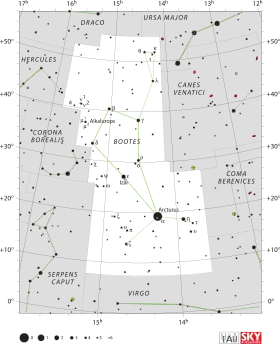Pi Bootis
Pi Bootis (π Boötis / π Boo), est une étoile triple probable[11] de la constellation boréale du Bouvier. Elle est visible à l’œil nu vavec une magnitude apparente combinée de 4,50[1]. En se basant sur une parallaxe annuelle de 10,67 mas[1], elle est localisée à environ ∼310 a.l. (∼95 pc) du Soleil.
(π Bootis)
| Ascension droite | 14h 40m 43,5609s[1] |
|---|---|
| Déclinaison | +16° 25′ 05,8863″[1] |
| Constellation | Bouvier |
| Magnitude apparente |
4,503 8[1] (4,893 + 5,761)[2] |
Localisation dans la constellation : Bouvier  | |
| Vitesse radiale | −1,1 ± 0,8 km/s[5] |
|---|---|
| Mouvement propre |
μα = +11,44 mas/a[1] μδ = +9,47 mas/a[1] |
| Parallaxe | 10,67 ± 1,35 mas[1] |
| Distance | ∼310 a.l. (∼95 pc) |
| Magnitude absolue | −0,39[6] |
| Masse | 3,49 ± 0,14 M☉[6] |
|---|---|
| Rayon | 3,2 ± 0,4 R☉[6] |
| Gravité de surface (log g) | 3,99 ± 0,18[7] |
| Luminosité | 214 L☉ |
| Température | 12 052 ± 456 K[7] |
| Métallicité | +0,18 ± 0,17 [Fe/H][7] |
| Rotation | 14,0 km/s[8] |
Autres désignations
π Boo, 29 Boo (Flamsteed), HIP 71762, BD+17°2768[9]
π1 Boo : HD 129174, HR 5475, SAO 101138[9]
π2 Boo : HD 129175, HR 5476, SAO 101139[10]
La composante primaire, π1 Bootis, est une étoile de magnitude apparente 4,89[2] de type spectral B9 IIIp (MnHgSi)[3], ce qui suggère qu'il s'agit d'une étoile évoluée géante bleue de type B. C'est une étoile chimiquement particulière de type HgMn[8] avec un spectre qui montre une surabondance anormale en mercure, manganèse et silicium[3]. Cette composante est très probablement elle-même une étoile binaire spectroscopique dont le compagnon est inconnu[11].
π2 Bootis est son compagnon visible, d'une magnitude apparente de 5,76[2]. Il s'agit d'une étoile blanche de la séquence principale de type spectral A6 V[3]. En 2010, les composantes de la paire π1 - π2 étaient séparées dans le ciel de 5,537 ± 0,003 secondes d'arc et à un angle de position de 110,5 ± 0,5°. Cela correspond à une séparation projetée de 538,6 ± 47,7 UA. La probabilité qu'il s'agisse d'un alignement visuel, fortuit, est de 0,85%[11].
Pi Bootis possède le nom traditionnel chinois 左攝提二 (Zuǒ shè tí èr).
Notes et références
- (en) Cet article est partiellement ou en totalité issu de l’article de Wikipédia en anglais intitulé « Pi Boötis » (voir la liste des auteurs).
- (en) F. van Leeuwen, « Validation of the new Hipparcos reduction », Astronomy and Astrophysics, vol. 474, no 2, , p. 653–664 (DOI 10.1051/0004-6361:20078357, Bibcode 2007A&A...474..653V, arXiv 0708.1752)
- (en) E. Høg et al., « The Tycho-2 catalogue of the 2.5 million brightest stars », Astronomy and Astrophysics, vol. 355, , p. L27 (DOI 10.1888/0333750888/2862, Bibcode 2000A&A...355L..27H)
- (en) H. A. Abt et O. Cardona, « The nature of the visual companions of Ap and Am stars », Astrophysical Journal, Part 1, vol. 276, , p. 266–269 (DOI 10.1086/161610, Bibcode 1984ApJ...276..266A)
- (en) B. Nicolet, « Photoelectric photometric Catalogue of homogeneous measurements in the UBV System », Astronomy and Astrophysics Supplement Series, vol. 34, , p. 1–49 (Bibcode 1978A&AS...34....1N)
- (en) G. A. Gontcharov, « Pulkovo Compilation of Radial Velocities for 35 495 Hipparcos stars in a common system », Astronomy Letters, vol. 32, no 11, , p. 759 (DOI 10.1134/S1063773706110065, Bibcode 2006AstL...32..759G, arXiv 1606.08053)
- (en) P. North, « Do SI stars undergo any rotational braking? », Astronomy and Astrophysics, vol. 334, , p. 181–187 (Bibcode 1998A&A...334..181N, arXiv astro-ph/9802286)
- (en) P. Prugniel, I. Vauglin et M. Koleva, « The atmospheric parameters and spectral interpolator for the MILES stars », Astronomy & Astrophysics, vol. 531, , A165 (DOI 10.1051/0004-6361/201116769, Bibcode 2011A&A...531A.165P, arXiv 1104.4952)
- (en) S. Ghazaryan et G. Alecian, « Statistical analysis from recent abundance determinations in HgMn stars », Monthly Notices of the Royal Astronomical Society, vol. 460, no 2, , p. 1912–1922 (DOI 10.1093/mnras/stw911, Bibcode 2016MNRAS.460.1912G)
- (en) * pi.01 Boo -- Star sur la base de données Simbad du Centre de données astronomiques de Strasbourg.
- (en) * pi.02 Boo -- Star sur la base de données Simbad du Centre de données astronomiques de Strasbourg.
- (en) M. Schöller et al., « Multiplicity of late-type B stars with HgMn peculiarity », Astronomy and Astrophysics, vol. 522, no A85, , p. 12 (DOI 10.1051/0004-6361/201014246, Bibcode 2010A&A...522A..85S, arXiv 1010.3643)
Liens externes
- (en) π1 Boo sur la base de données Simbad du Centre de données astronomiques de Strasbourg.
- (en) π2 Boo sur la base de données Simbad du Centre de données astronomiques de Strasbourg.
- (en) James B. Kaler, « Pi Bootis », sur Stars
- « Image de Pi Boötis », sur la base de données Aladin